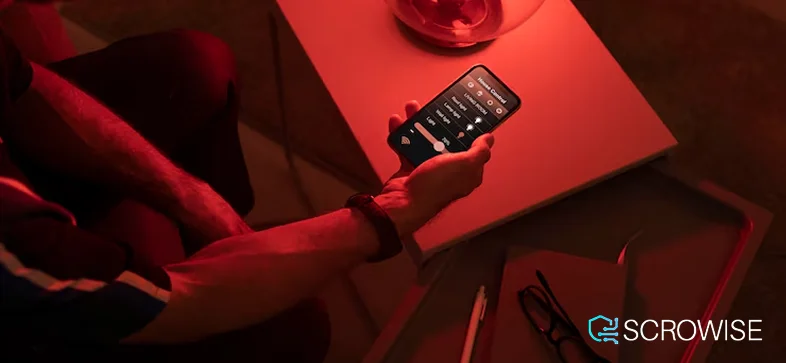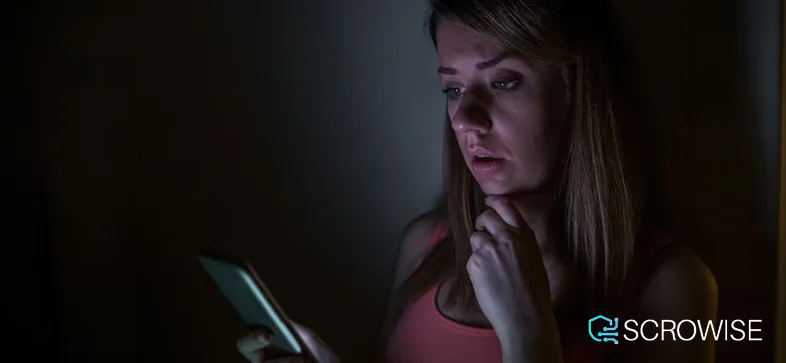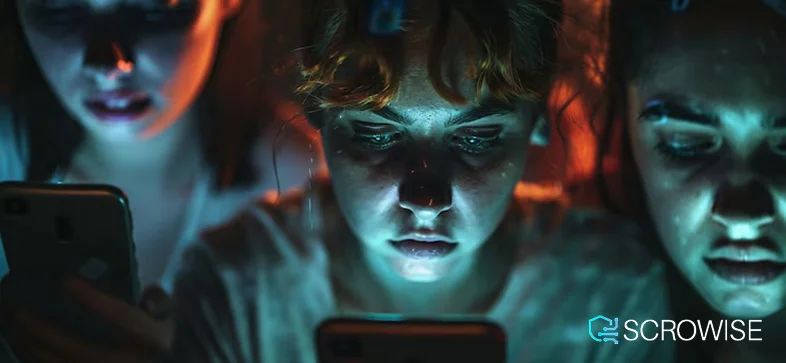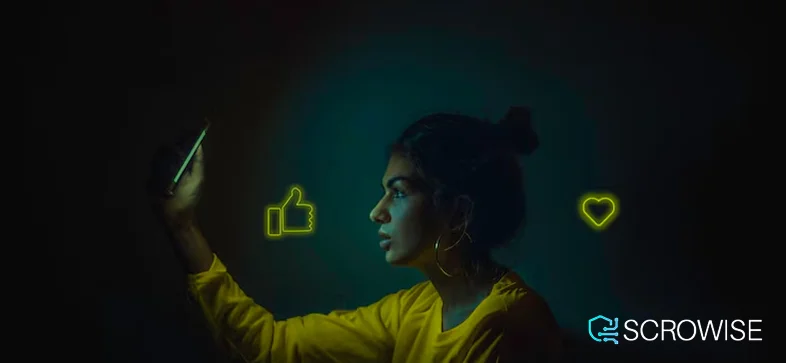Ever noticed your website gets visits that seem to appear out of nowhere? You check your analytics, hoping to find where these visitors came from, only to see that frustrating “direct traffic” label. But you know these aren’t people typing your URL directly.
This mysterious traffic is likely coming from dark social – and it might represent up to 84% of all consumer outbound sharing from websites.
In this guide, we’ll break down exactly what dark social is, why it matters to your marketing strategy, and actionable ways to harness its power rather than remain in the dark!
Introduction to Dark Social: The Hidden Traffic Source

Dark social isn’t as ominous as it sounds. The term, coined by Alexis Madrigal in 2012, refers to the social sharing that analytics platforms can’t track. It’s the traffic that arrives at your website without referral information – making it impossible to identify where it came from.
What Exactly Qualifies as Dark Social Traffic?
Dark social happens when people share their content through private channels rather than public social platforms. This includes:
- Messaging apps like WhatsApp, Facebook Messenger, and Telegram
- Email shares (sending links directly to friends)
- SMS and text messages
- Secure browsing sessions
- Native mobile apps
- Clicks from HTTPS to HTTP sites
When someone shares your link through these channels, the person clicking arrives at your site without the usual referral data, often being categorized as “direct traffic” in your analytics.
Why Dark Social Has Remained Under the Radar
Most marketing teams focus their attention on visible metrics – likes, shares, retweets – the stuff that’s easy to measure. But this overlooks how people naturally communicate online.
The reality is, we don’t share everything publicly. When we find an article about health issues, financial advice, or a product we’re considering buying, we’re more likely to send it directly to relevant people rather than broadcast it to our entire social network.
Analytics platforms struggle with dark social because:
- Messaging apps are often encrypted
- Email clients strip referral data for privacy
- Mobile apps don’t pass complete tracking information
This creates a significant blind spot in most marketing strategies.
The Surprising Volume of Dark Social Sharing
Here’s what makes dark social impossible to ignore: it’s massive. Research from RadiumOne found that dark social accounts for approximately 84% of outbound sharing. GetSocial discovered that dark social drives 3x more traffic than Facebook across the board.
For certain industries, the numbers are even more dramatic:
- Travel and hospitality: 89% of shares happen via dark social
- Consumer goods: 92% of shares
- Home and lifestyle: 76% of shares
These aren’t small numbers. That’s the majority of your content sharing happening where you can’t easily track it.
Understanding the Origins and Evolution of Dark Social

Dark social isn’t new – it’s actually the original way people shared online.
How Private Messaging Transformed Digital Communication
Before social media existed, people shared interesting content via email. As digital communication evolved, our sharing habits diversified but remained fundamentally private in many contexts.
The explosion of messaging apps accelerated this trend. WhatsApp alone handles over 100 billion messages daily. These platforms combine convenience with privacy, making them perfect for sharing content with specific people.
Today’s internet users are increasingly selective about where and how they share. When something matters, we tend to share it privately with the people who would find it most relevant.
The Rise of Encrypted Platforms and Privacy Concerns
Growing privacy concerns have pushed users toward encrypted, private sharing channels:
- WhatsApp implemented end-to-end encryption in 2016
- Signal and Telegram gained popularity specifically for their privacy features
- Apple’s iMessage has always been a closed ecosystem
This shift isn’t slowing down. As users become more privacy-conscious, dark social prominence will only increase.
5 Key Differences Between Dark Social and Visible Sharing
Understanding how dark social differs from public social sharing helps explain its importance:
- Intent: Dark social shares typically demonstrate higher intent and relevance. People share with specific individuals because they believe the content is directly valuable to them.
- Trust factor: Content shared privately carries an implicit endorsement from someone you know personally, making it more influential than public posts.
- Targeting precision: Dark social is naturally targeted – people only share with those who they believe will be interested.
- Conversation context: Private shares often include personalized messages that add context and relevance.
- Conversion potential: Content received through dark social converts at significantly higher rates than content discovered through public channels.
These differences explain why dark social traffic often outperforms other traffic sources in terms of engagement and conversion metrics.
The Major Dark Social Channels Marketers Should Know

To tackle dark social, you first need to understand where it’s happening.
Messaging Apps: WhatsApp, Messenger, and Telegram Analysis
WhatsApp dominates global messaging with over 2 billion active users. It’s particularly powerful for dark social in Europe, Latin America, and Asia. The app’s focus on privacy means nearly all sharing happens without trackable referrals.
Facebook Messenger remains significant with 1.3 billion users, especially in North America. While part of the Meta ecosystem, most Messenger shares still arrive as dark social traffic.
Telegram’s user base has grown to over 700 million, with its enhanced privacy features making it especially popular for dark social sharing in certain regions and demographics.
Key insight: These platforms all offer business solutions (WhatsApp Business, Messenger for Business), but they don’t solve the attribution problem of dark social.
Email Sharing: The Original Dark Social Channel
Despite predictions of its demise, email remains one of the most significant dark social channels. With 4 billion global users sending 306 billion emails daily, it’s still how many people share content privately.
Email sharing is especially prevalent among:
- B2B audiences
- Higher education segments
- Professional services
- Older demographics
The challenge with email sharing is that most email clients strip referrer information for security reasons, causing these visits to appear as direct traffic.
Private Social Media Interactions Worth Tracking
Not all social media activity happens publicly. Private interactions on social platforms include:
- Direct messages on Instagram, Twitter, and LinkedIn
- Facebook Group discussions
- Instagram Close Friends stories
- Private subreddit sharing
These enclosed ecosystems create significant dark social traffic that your analytics can’t attribute to their source.
Why Dark Social Matters: Impact on Marketing Strategy

Dark social isn’t just a technical curiosity – it fundamentally changes how you should approach digital marketing.
How Dark Social Influences Consumer Purchase Decisions
Research from Radarly shows that 77% of consumers are significantly influenced by dark social conversations when making purchase decisions.
This makes sense when you consider how we naturally shop:
- Find something interesting
- Ask friends or family for their opinions via private messages
- Make purchase decisions based on trusted feedback
This hidden influence chain happens constantly but remains invisible to most marketers. The products and services being discussed privately gain a significant advantage without the brand even knowing it.
The Trust Factor: Why People Share Privately
People share differently in private channels. Public sharing often focuses on personal image management – sharing content that makes you look good to your broader network.
Private sharing prioritizes value and relevance. When someone shares your content privately, they’re saying: “I thought specifically of you when I saw this.”
This targeted relevance dramatically increases engagement potential:
- Private recommendations are trusted 3x more than brand advertising
- Content shared through dark social has a 10% higher conversion rate on average
- Recommendations from friends or family still outrank all other forms of marketing in terms of trust
Missing Attribution: What Your Analytics Aren’t Showing
The biggest challenge with dark social is attribution. When visitors arrive through dark channels, analytics platforms typically:
- Classify them as “direct traffic”
- Provide no insight into which content was shared
- Offer no visibility into which campaigns generated the sharing
This creates a flawed view of your marketing performance. Campaigns that generate significant dark social sharing may appear to underperform in your analytics despite driving substantial traffic and conversions.
For content marketers, this problem is particularly acute. The very best content – the kind people want to share privately with friends – often receives the least attribution.
7 Practical Methods to Track Dark Social Traffic

While perfect tracking is impossible, you can implement strategies to better measure and understand your dark social traffic.
Implementing Shortened URLs with Custom Parameters
Create trackable links with UTM parameters specifically for content likely to be shared privately:
- Use a URL shortener like Bitly or Rebrandly
- Add UTM parameters to track campaigns, content, and source
- Create memorable, clean short URLs that work well in messaging apps
Example: Instead of sharing `yourbusiness.com/blog/ultimate-guide-to-product`, create `yourbiz.link/ultimate-guide` with embedded tracking.
This won’t catch all dark social sharing, but it provides better data than standard links.
Creating Dedicated Share Buttons for Easy Tracking
Implement sharing buttons specifically for private channels:
- “Email to a friend” buttons with tracking parameters
- WhatsApp and Messenger share buttons that add UTM codes
- “Copy link” buttons that automatically add tracking information
Make these options prominent on high-value content. The easier you make tracked sharing, the more data you’ll capture.
Key design tip: Place these buttons alongside traditional social share buttons, but optimize their visibility based on your audience’s preferences.
Advanced Analytics Techniques for Dark Social Insights
Beyond basic tracking, implement these advanced techniques:
- Segment direct traffic by landing page: Direct traffic to your homepage might be genuinely direct, but direct traffic to a deep blog post is likely dark social.
- Implement “how did you hear about us?” fields on key conversion forms to capture self-reported referral data.
- Use fingerprinting techniques that identify patterns in dark social traffic based on user behavior.
- Deploy alternative analytics solutions like GetSocial or Po.st that specialize in dark social tracking.
- Create dark social dashboards in Google Analytics that segment probable dark social from true direct traffic.
While none of these methods provide perfect tracking, together they create a clearer picture of your dark social impact.
How Top Brands Are Successfully Leveraging Dark Social

Forward-thinking brands aren’t just tracking dark social – they’re actively encouraging it.
Case Study: Converting Dark Social into Measurable Results
Adidas recognized the power of dark social early. They created “Tango Squads” – groups of football influencers connected through messaging apps in 15 key cities worldwide.
Instead of broadcasting content publicly, Adidas shared exclusive content, product previews, and insider information through these private channels first.
The results were remarkable:
- 1,400% higher engagement than their public social media
- Significantly higher conversion rates on product launches
- Authentic peer-to-peer sharing that amplified their message
By embracing dark social rather than fighting it, Adidas created a marketing approach that aligned with how their audience naturally communicates.
Engagement Strategies That Encourage Trackable Sharing
Smart brands design content specifically for private sharing while building in tracking mechanisms:
- Exclusive access codes: Warby Parker encourages customers to share unique referral codes via dark social, making tracking natural.
- Personalized sharing tools: Spotify’s “Wrapped” campaign includes personalized share cards designed for private messages.
- Value-driven content: American Express creates financial guides designed to be shared with family members planning major purchases.
The common thread is creating genuine value that people naturally want to share privately, while building tracking into the sharing mechanism itself.
Building Communities That Generate Dark Social Buzz
Private communities are becoming central to dark social strategy:
- Discord servers that create exclusive spaces for brand conversations
- WhatsApp groups centered around specific interests or products
- Private Facebook Groups that foster community discussions
These spaces create ideal conditions for dark social sharing, and while not everything can be tracked, they allow brands to participate in and influence private conversations.
Developing Content Specifically for Dark Social Sharing

Creating content optimized for dark social requires a different approach from traditional social media content.
What Makes Content Highly Shareable in Private Channels?
Content that thrives on dark social typically has these characteristics:
- High utility value: Practical information people want to save or share with others facing similar challenges.
- Specific relevance: Content that addresses niche problems or very specific situations that make people think “This is perfect for [specific person].”
- Conversation starters: Content that naturally prompts discussion or debate between friends.
- Trust signals: Authoritative information on sensitive topics people wouldn’t discuss publicly.
- Identity reinforcement: Content that helps reinforce relationships between the sharer and recipient.
Data shows that certain content categories perform exceptionally well on dark social:
- Health and wellness information (76% shared via dark channels)
- Financial advice (81% dark social sharing)
- Parenting tips (72% dark sharing)
- Major purchase research (68% dark sharing)
Creating Valuable Resources That Prompt Natural Sharing
Focus on creating these high-performing content types:
- Comprehensive guides: In-depth resources that solve specific problems are frequently shared privately.
- Calculators and tools: Interactive resources that help with decision-making generate significant dark social traffic.
- Checklists and templates: Practical resources people share with others working on similar projects.
- Decision-making content: Product comparisons, buying guides, and reviews that help with purchase decisions.
The key is creating content valuable enough that sharing it privately feels like doing someone a favor.
Conversation Triggers: Content That Sparks Discussion
Some content naturally prompts private conversations:
- Question-based formats: Content that poses thoughtful questions people want to discuss with specific friends.
- Surprising data points: Statistics or findings that challenge conventional wisdom and spark debate.
- Future predictions: Forward-looking content that encourages people to share and discuss possibilities.
- Identity-based content: Information that strongly connects with specific identities, professions, or life situations.
These formats don’t just get shared – they initiate conversations that build deeper engagement with your brand.
The Future of Dark Social: Trends and Predictions

The importance of dark social is only increasing. Here’s what’s coming next:
How Privacy Changes Will Affect Dark Social Tracking
The digital ecosystem is moving toward greater privacy protection:
- Browser changes continue to restrict tracking capabilities
- Privacy legislation like GDPR and CCPA limits data collection
- Major platforms are reducing third-party data access
These changes will make traditional social attribution even more challenging while increasing dark social’s prevalence.
Smart marketers are preparing by:
- Building first-party data strategies
- Developing consent-based tracking approaches
- Creating content that performs well regardless of attribution challenges
Emerging Technologies for Better Dark Social Attribution
New solutions are emerging to address dark social tracking:
- AI-powered attribution models that identify likely dark social traffic patterns
- Privacy-preserving fingerprinting that identifies traffic sources without compromising user data
- Blockchain-based attribution systems that maintain privacy while providing better tracking
- Enhanced UTM frameworks specifically designed for messaging app environments
These technologies won’t solve everything, but they’ll provide better visibility into what’s currently hidden.
Why Dark Social Will Become Even More Crucial by 2025
Several trends point to dark social’s growing importance:
- Generational shifts: Younger users increasingly prefer private messaging to public social media.
- Messaging app evolution: Platforms like WhatsApp and Telegram are becoming complete ecosystems, not just communication tools.
- AI-driven personalization: As AI improves, the value of sharing relevant content with specific individuals increases.
- Social media fatigue: Public sharing continues to decline as users experience burnout from performative social media.
By 2025, brands without a dark social strategy will likely be missing the majority of their social sharing impact.
Conclusion: Integrating Dark Social into Your Marketing Mix
Dark social isn’t really “dark” – it’s simply a return to how humans naturally share information: through private, relevant, one-to-one conversations.
Creating Your Dark Social Action Plan Today
Start with these practical steps:
- Audit your current analytics to identify probable dark social traffic
- Implement basic tracking mechanisms for your most valuable content
- Create sharing tools that make private sharing easier and more trackable
- Develop content specifically designed for dark social channels
- Build communities where private sharing can flourish
The goal isn’t to eliminate dark social or track everything – it’s to work with how people naturally communicate.
Balancing Measurement with Authentic Engagement
The brands that will win with dark social are those that recognize its fundamental nature: it’s human, authentic, and built on trust.
Focus less on perfect attribution and more on creating content so valuable that people naturally want to share it privately. This mindset shift is more important than any tracking technology.
Key Takeaways for Modern Marketing Strategy
- Dark social represents the majority of content sharing but remains largely invisible in analytics
- Private sharing indicates higher relevance, trust, and conversion potential
- Content designed specifically for dark social performs differently from public social content
- The future of social sharing is increasingly private, making dark social strategy essential
The marketers who embrace dark social now won’t just improve their analytics – they’ll create more relevant, human-centered content that aligns with how their audience naturally communicates.
And that’s the real opportunity of dark social: not just better tracking, but better marketing.
FAQs
What is dark social marketing?
Dark social marketing refers to online sharing that occurs through private channels like messaging apps, email, and private groups, making it hard to track.
What is an example of a dark social post?
A dark social post could be a link shared privately via WhatsApp, Facebook Messenger, or an email, where the traffic source is not visible to analytics tools.
What is the dark social background?
Dark social originates from the rise of private online communication, where sharing happens outside of visible social media platforms, making it challenging to track engagement.
Is WhatsApp a dark social?
Yes, WhatsApp is considered dark social because users share content privately through messages, which doesn’t get tracked by traditional analytics tools.
How to track dark social?
To track dark social, use UTM parameters, track referral traffic from unknown sources, and employ specialized analytics tools that can capture untracked sharing behavior.

